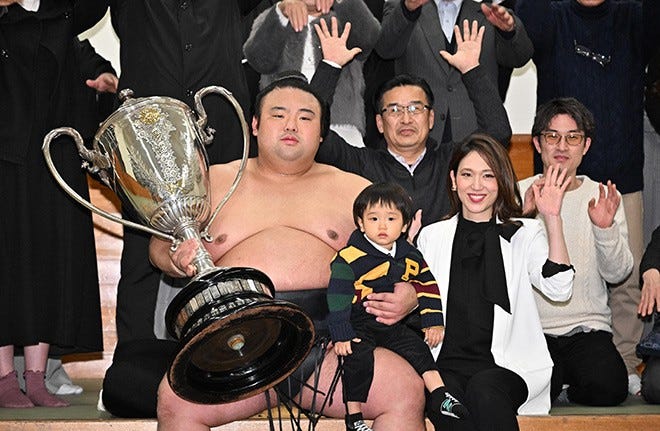Three clusters of kimarite style - throwing a little spin adds interest
Of course, it's Midorifuji
Adding onto the cluster analysis I did last time, using the “polar style”, one uses the distance metric (continuing with the Hellinger metric on kimarite of wins), and then picks one more “pivot” that is maximally distant from the first two poles one has already picked.
So, having picked Hokuseiho and Takakeisho…
Midorifuji, the next pivot
The next pick is no surprise: Midorifuji!
In my profile on Midorifuji, I was comparing him against the overall sumo database:
That’s not how this cluster analysis works, which is why it was Hokuseiho and Takakeisho who were the first picks.
In this one, we’re comparing the wrestlers against each other, not against the overall database average.
Different clustering approaches
In addition, I’m looking not for central tendencies, but extreme tendencies.
There is a standard clustering technique called k-means clustering, which is a centralizing clustering method, which could also work using such a metric, but it is computationally annoying (I don’t want to explain what I mean by that right now — those who know, know.) I may do a k-means clustering when I have time to actually code this, because the Hellinger metric is not a standard metric for this.
I decided to make an excuse, as the polar/pivoting approach I’m taking, which I’ve used for interest rate scenario modeling for tail risk measurement (yes, really — I’m an actuary who has worked with variable annuities).
The approach I’m using picks out extreme examples for a cluster - it is picking a defining rikishi for each of my “kimarite clusters” that is intended to be as far as possible from the other “poles” or “pivots”.
One way of describing it is that they are as “pure” an example of the strategies they represent.
As in my prior post, Hokuseiho and Takakeisho represent yorikiri and oshidashi strategies very heavily in Makuuchi.
So… who splits the difference?
Midorifuji is the Man
What one does is look for the rikishi who is farthest away from both Hokuseiho and Takakeisho using the Hellinger metric.
So: you take each rikishi, measure their distance to the pole they’re closest to, and then find out which has the maximum distance.
Midorifuji is it.
Again, we see the oshidashi and yorikiri extremes for Takakeisho and Hokuseiho.
But what is Midorifuji doing?
His top kimarite is katasukashi, which is really weird, as I mentioned in his profile.
But the main thing is that Midorifuji has a wide variety of moves, mainly throws, that he uses to win.
The three-cluster world
Rather than listing the names, let’s look at a scatterplot by weight & height to see if we can see a pattern:
So that you don’t have to count, the Midorifuji crew is smaller than the other two.
In my first slice, Hokuseiho and Takakeishio split Makuuchi roughly in half, but that was just luck. They didn’t have to.
Now that we add more clusters, we start to see how the distribution can be lopsided:
Hokuseiho cluster: 15
Takakeisho cluster: 19
Midorifuji cluster: 8
I want to comment on one of the members of the Midorifuji cluster — no, not my man Ura.
Nope: Kotonowaka.
It is very strange to me. He’s the “most boring” guy — but maybe it’s because he’s balanced between oshidashi and yorikiri, instead of completely unbalanced, that he is thrown into the Midorifuji crowd. I think that’s interesting.
What happens as you add clusters?
I will likely add at least one more cluster, just to see what happens, but adding too many, it starts to get to be uninterpretable.
In the particular “pivot” approach I’m taking, pivots generally do not get isolated, but get a few of the members of their clusters taken away from them with the addition of a new pivot. It depends on the distribution of the original data.
Given how much oshidashi and yorikiri are the top winning moves among rikishi, even in Makuuchi, I think the Hokuseiho and Takakeisho clusters will continue to dominate.
But as I noted with Kotonowaka above, he almost exactly matches the overall percentages of oshidashi and yorikiri for the sumo database, instead of favoring one or the other — maybe he would be my next pivot…. hmmmmmmmm.
Two of the Versatile Crew
Yes, this is a scripted match, for the winter tour to entertain the public — Ura v. Midorifuji.
Click through to Instagram to watch.
Enjoy!







